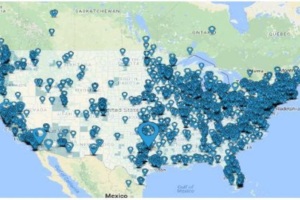The Checkology® virtual classroom has gone viral worldwide
When NLP rolled out its dynamic Checkology® virtual classroom last May, our goal was to be in all 50 states with 100,000 registered students by the end of 2017.
 We’re just three months into 2017, and we have already enrolled 6,200 educators who teach 775,000 students in urban, suburban and rural areas throughout the United States and in at least 46 countries around the globe, from China to Turkey to South Africa to Brazil to Australia.
We’re just three months into 2017, and we have already enrolled 6,200 educators who teach 775,000 students in urban, suburban and rural areas throughout the United States and in at least 46 countries around the globe, from China to Turkey to South Africa to Brazil to Australia.
Interest surged following the presidential election and the disclosure of the prevalence and power of online rumors, hoaxes and conspiracy theories (“fake news”), accompanied by a growing national debate about the nature and value of real news. Amid increased awareness of the challenge that students face in determining what information to trust, educators have embraced the opportunity to teach core news literacy skills and concepts — including how to detect bias, how to dissect viral rumors and how to use the standards of quality journalism to find credible information.
As teachers bring news literacy to their classrooms, students are recognizing their own need to be news-literate.
“Now we need it even more,” said Catherine Dievendorf, a senior at Alta Loma High School in Rancho Cucamonga, Calif. “Consuming news and media blindly destroys our understanding and awareness of bias and deceit that could permeate our news.”
The virtual classroom includes 12 core lessons and supplemental tools that teach news literacy skills and encourages students to apply what they are learning to the news and information they encounter every day. By doing so, they develop the critical-thinking skills that are essential for informed and engaged citizens in a democracy.
The Basic version of the platform provides a single login for teachers and permits them to deliver the lessons in a one-to-many format (on an LCD projector, for example). The Premium version provides subscribers with individual student logins to unlock the full virtual classroom experience, including one-to-one delivery, self-pacing, remediation, individual assessments, points, badges and student discussion.
We’ve received feedback from teachers right from the start, and the spring pilot of the Premium version, which will extend through June, incorporates many of the changes they requested. These include making it more efficient for teachers to offer online feedback to students and giving them more options for student remediation, for blending whole class and individual instruction and for sharing announcements and notifications. We’re also updating examples of information in some lessons and improving key aspects of students’ experience.
Educators: Sign up here to participate in the spring pilot, then share this link with your fellow teachers in middle schools and high schools, librarians, and leaders of after-school programs.